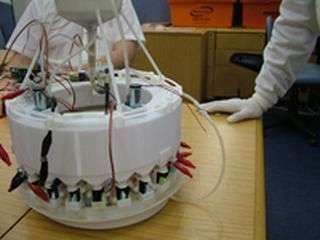July 20, 2010 report
Self-sustaining robot has an artificial gut (w/ Video)

(PhysOrg.com) -- UK researchers have developed an autonomous robot with an artificial gut that enables it to fuel itself by eating and excreting. The robot is the first bot powered by biomass to be demonstrated operating without assistance for several days. Being self-sustaining would enable robots of the future to function unaided for long periods.
The robot, the Ecobot III, was developed by researchers at the Bristol Robotics Laboratory and will be presented at the Artificial Life conference in Denmark in August. The robot eats meals of partially processed sewage, using the nutrients within the mash for fuel and excreting the remains. It also drinks water to maintain power generation.
The robot navigates towards a dispenser filled with the nutrient-rich mixture and "eats" what it needs. The meal is then processed in the robot's body by bacteria held in a stack of two tiers, each with 24 microbial fuel cells (MFCs).
Undigested matter passes via a gravity feed to a central trough from which it is pumped back into the feeder tanks to be reprocessed in order to extract as much of the available energy as possible. The waste is then purged every 24 hours by a peristaltic pump that works like the colon, using pressure waves to expel the waste from the tube into a litter tray.
The bacteria in each MFC metabolize the mixture, producing hydrogen atoms in the process. The hydrogen electrons are drawn to the fuel cell anode where an electric current is generated. Meanwhile the hydrogen ions enter the cathode chamber via a proton-exchange membrane and combine with oxygen in the water in the chamber to produce more water. The robot drinks water to replace losses through evaporation.
Director of Bristol Robotics Laboratory, Chris Melhuish, said MFCs had been tried before but an artificial gut was needed to solve the problem of previous models, which was that humans had to clean up the waste left by bacterial digestion. Melhuish said the robot was called Ecobot III, but admitted “diarrhea-bot would be more appropriate, as it’s not exactly knocking out rabbit pellets.”

The robot has maintained itself unaided for up to seven days, but is so far extremely inefficient, using only 1% of the energy available within the food. It moves slowly and shows some intelligent behaviors such as moving toward light.
The inefficiency and slowness may make the robot less attractive than autonomous robots designed to extract energy from biomass by burning it rather than using MFCs — such as the "Energetically Autonomous Tactile Robot" being developed by the US military — but the Bristol team point out that MFCs can process a greater range of foodstuffs, including hard-to-burn matter such as waste water.
The efficiencies should be improved in the future, which may make the robots ideal for domestic and other non-military uses. The robot could also potentially be used to clean waste water.
More information:
Ecobot III project page: www.brl.ac.uk/projects/ecobot/ecobot%20III/index.html
via Newscientist
© 2010 PhysOrg.com



















